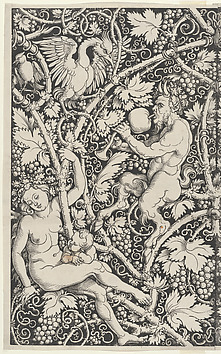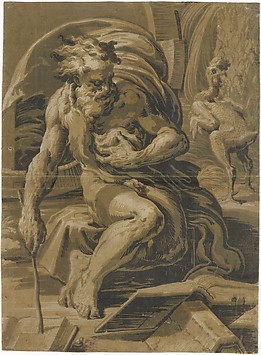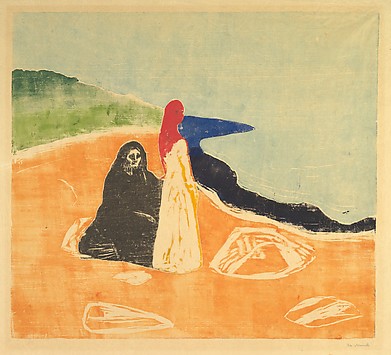
Woodcut

The oldest form of printmaking, woodcut is a relief process in which knives and other tools are used to carve a design into the surface of a wooden block. The raised areas that remain after the block has been cut are inked and printed, while the recessed areas that are cut away do not retain ink, and will remain blank in the final print.
The wooden block is usually made from pear wood, which is sawn along the grain and planed smooth. The block is then seasoned to reduce the moisture content in the wood, which prevents warping and cracking. The size of the woodblock is determined by the image, but is ultimately limited by the size of the printing press. This means that for a large-scale print, multiple blocks are cut and printed separately, after which the image is assembled. Smaller blocks are less likely to crack due to age or the pressure placed upon them during the printing process. The thickness of the block is also important for ease of use and the prevention of wear; the ideal thickness is around one inch.
After the woodblock has been prepared, the design can be drawn directly onto the surface of the block or a sketch can be pasted on to it. Alternatively, the design can be transferred from a sheet of paper directly onto the surface of the block by applying chalk or graphite to the back of the sheet. The design is then placed onto the surface of the block and its lines are traced by the printmaker with a stylus, which transfers the chalk and the thus the design onto the block.

Woodblocks are most often cut by a professional block cutter, who uses a chisel, gouge, or knife to carefully cut away sections of the block that will not receive ink.

The lines that comprise the image then stand in relief to the rest of the block (which is why woodcuts are in the group of printmaking techniques called relief prints).

The block is then inked evenly by using a dauber (ink ball) or a roller, taking care not to spill ink into the recesses.

The block is then placed on the bed of a press and a sheet of dampened paper is placed onto the inked surface of the block. Printmakers can use either a platen press or a roller press. Although some early relief prints appear to have been produced by simply pressing the paper against the block with one's hand, the use of a press is preferable for the consistent distribution of ink.

Once printed onto its paper support, the woodcut's design appears in reverse of the original on the block.

Liz Zanis (American, born 1980). Big Rocks, 2018. Woodcut and woodblock. Courtesy of the artist
Marquee image: Christoffel Jegher (Flemish, 1596–1652/53), after Peter Paul Rubens (Flemish, 1577–1640). The March of Silenus (detail), ca. 1652. Woodcut, sheet: 17 5/8 x 13 3/8 in. (44.7 x 33.9 cm). The Metropolitan Museum of Art, New York, The Elisha Whittelsey Collection, The Elisha Whittelsey Fund, 1951 (51.501.7695)


